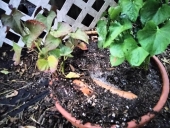Bags of leaves around the foundation - like bales of straw but free and can use them on garden in the spring. We once knew someone in Wisconsin who insulated a cold dairy barn with many layers of flattened cardboard boxes stapled onto the walls (there was hay in the loft so the top was already insulated). With the cows inside it felt cozy. Bubblewrap can be applied to windows by misting the glass with water, then press the bubblewrap's smooth side against the glass and it will stay in place until you peel it off in the spring, no tape or adhesives needed. And yes, you should try to insulate a smaller space in the structure and concentrate the heat there rather than trying to keep the whole space warm. Wear lots of layers of wool, silk, or other animal fibers. Fingerless gloves and hats are useful indoors as well as out.






